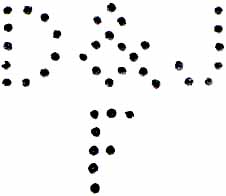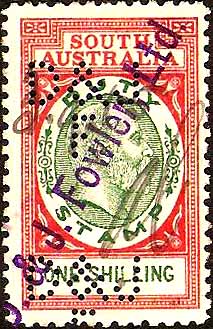|
Private Revenue Perfins of South Australia An Elsmore Coath production The authors would welcome your comments additions or input into this work D -------------------------------------------------------- D&J/F.a .b
User: D&J Fowler Ltd Merchants & Shipping Address: 14-18 King William St, Adelaide SA. Revenue Use: 1876 Series 1/-. 1883 Series 3d, 6d. 1902 Series 1d. 1904 Series 1d, 6d, 1/. 1906 Two Pence on 1d. 1916 Series 1/-. Rarity Scale: 1876 Series 1/- R4. 1883 Series 3d R2, 6d R1. 1902 Series 1d R2. 1904 Series 1d R3, 6d R3, 1/- R3. 1906
Two Pence on 1d R1, 1916 Series 1/- R1. Background: *David (born 1826) and George (born 1839), Fowler, were born in Scotland, sons of James Fowler, grocer, merchant and Baptist pastor. David worked in his father's business and in 1854 with his wife Janet, their two children, a servant and goods worth £2,300 he immigrated to Australia arriving in Adelaide in November that year on the “Fop Smit”. There he joined his eldest brother James and sister Margaret who had been in Adelaide since November 1850. James and David promptly opened a retail grocery with the stock that they had brought from England. Competition was strong but by 1857 they had grown to the point that they could acquire new premises in King William Street, Adelaide as well as enter the import trade. After a period of illness James died in 1859 and Margaret returned to Scotland. David’s younger brother George, who was then working with their father, agreed to come to Adelaide and in July 1860 he, and Margaret, arrived via the steamship “Indus”. David and George formed a new trading company and pooled their joint assets of nearly £20,000. In 1865 they decided to cease their retail trade in order to concentrated on the wholesale business, and to this end David visited Britain to set up a buying office in London. David settled in London in 1873 to manage that office leaving George in Adelaide. David died in London in November 1881 aged 55. By the 1880’s D. & J. Fowler had grown to be one of the major commercial houses in the South Hemisphere'. As well as its head office in Adelaide the company had branches in London and Fremantle, agencies in the Northern Territory and on the River Murray, large stores in Port Adelaide and other suburbs, big depots for kerosene and factories for the production of jam, condiments, confectionery and preserved fruit. They also ran a large shipping agency, importing foodstuffs and exporting wool, wheat, flour, meat, butter, copper and tanning bark. By 1896 the firm had spread to Broken Hill and Kalgoorlie, and acquired the bankrupt Adelaide Milling Co. and eleven other flour-mills, and won a leading place as dried fruit packers on the Murray irrigation settlements. George was elected to the South Australian Parliament winning the seat of East Adelaide in 1878, represented South Australia at the inter-colonial convention on tariffs in 1880 and served as treasurer for two months in Morgan’s ministry in 1881 before loosing his seat in 1884. George died in October 1896. The family involvement in the company continued with George’s eldest son, James (born May 1865) becoming a Director in 1892 and remaining with the company until his death in December 1939. Device: The D&J/F.a and .b device is the first perforating device to be used in the Australian States. The approval for its use was granted on 27 September 1877 by the postal department in Adelaide, South Australia but the device was not made until later. The device was a 2 die device with the dies in a vertical array and the perforator was manufactured in early 1880 by Joseph Sloper in London, England. A sample strike [Sloper number 5457] is to be found in the Sloper Workshop Impression Book. Because of the rather tall format of many South Australian revenue and postage stamps strikes of the 2 dies of the device can often be seen together on the same stamp when the strikes appear in positions 1,3,5 or 7. The 2 dies are very similar but they can be identified by the shape of the top of the F. In the upper die (D&J/F.a) the top of the F bows slightly upward and in the lower die (D&J/F.b) the top of the F bows slightly downward. Because the dies are discernable we list them as 2 patterns. The device had a long life and is found used until the mid 1950’s. Related patterns: Nil * Australian Dictionary of Biography-------------------------------------------------------- © copyright 2011 |

